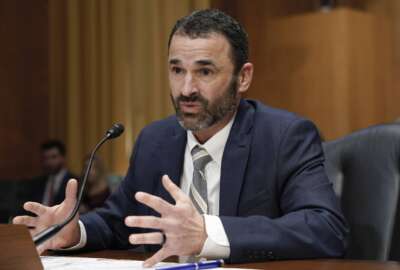Hubbard Radio Washington DC, LLC. All rights reserved. This website is not intended for users located within the European Economic Area.
Cutting Costs, Not Missions
How can agencies reduce inefficiencies and redundancies without significantly impacting their core missions? Hear what Robin Lineberger, John Powers and JoAnne ...
wfedstaff | June 4, 2015 3:36 pm
Congress enacted legislation that requires $1.2 trillion dollars in budget cuts before January of 2013—but determining where cuts should be and how they should be implemented can be a challenge. So how can agencies reduce inefficiencies and redundancies without significantly impacting their core missions? One approach is through merging, integrating, consolidating and divesting.
Guests:
Robin Lineberger, CEO of Federal Government Services, Deloitte LLP
John Powers, Principal, Deloitte Consulting LLP, and Managing Partner of Mergers , Acquisitions and Restructuring Practice – of Deloitte Consulting LLP
JoAnn Boutelle, Partner, Deloitte & Touche LLP – Former Deputy CFO of the U.S. Department of Defense
Show Highlights:
• Why the “peanut-butter spread” approach to cost reduction may not work this time around
• Making effective budget cuts through merging, integrating and consolidating
• Taking a three-step approach to implementing change
• Lessons learned from the commercial sector
• Factors that contribute to an effective transformation
The following is a full transcript of FedCentral’ s interview with Robin Lineberger, John Powers and JoAnne Boutelle conducted by Jane Norris on January 4, 2012.
Jane Norris
Welcome to Fed Central, brought to you by Deloitte – a program where executives and Federal government leaders talk about the issues and initiatives that are making a real impact on the business of government today, to help government help America – thanks for joining us.
Today we’re discussing cost-cutting in the Federal government, specifically how agencies can reduce inefficiencies and redundancies in their organizations without significantly impacting their core missions. Congress enacted legislation that requires $1.2 trillion in budget cuts before January of 2013. But where these cuts are made and how they will be implemented is a matter of discussion.
Here to offer insights about the government’s potential to save dollars through merging, integrating and consolidating are Robin Lineberger, CEO of Deloitte’s Federal Government Services and within Deloitte Consulting LLP. It’s a $1.3 billion practice with more than 6,100 employees. Under Robin’s leadership, Deloitte Federal Government Services provides consulting, risk advisory and financial advisory services to every Cabinet-level agency in the U.S. government. Hi, Robin.
Robin Lineberger
Good morning.
Jane Norris
And John Powers is a managing director at Deloitte Consulting LLP. He’s the current leader of mergers and restructuring in Deloitte’s Federal Practice. For more than seven years, John has led the planning and execution of consulting services for transactions totaling more than $100 billion in value. His specialties include developing integration strategies, designing global governance programs, and creating validation approaches for services focused on merging and restructuring public and private organizations. Hi, John.
John Powers
Good morning.
Jane Norris
And JoAnn Boutelle, a partner with Deloitte and Touche LLP, is a former deputy CFO of the U.S. Department of Defense. While at the DoD, she was recognized as a committed leader to reforming business processes. JoAnn continues that work at Deloitte, where she helps clients take costs out of their activities through reengineering processes, integrating and divesting functions, and enhancing business processes with technology. Hi, JoAnn.
JoAnn Boutelle
Good morning, Jane.
Jane Norris
Well, this is a great group. It’s a pleasure to have you all here. So let’s talk a little bit about how the Federal government is going to approach some of its cost pressures. Robin, I’ll start with you. The Joint Select Committee on Deficit Reduction, the so-called Super Committee, failed to meet its objective – meaning automatic sequestration cuts will begin in 2013. So how do you see the U.S. government effectively making those cuts?
Robin Lineberger
Well, there are a couple approaches that they can take. I think, first, as they begin passing on the dollarized cuts to the various agencies across the board, providing guidance to the organizations of what the priorities are, what they should continue doing and what they should consider reducing.
Secondly, as the agencies receive their budget numbers, it could be tempting to take this classic peanut butter approach, spreading the cuts evenly across the organization. But I would suggest we take a look at prioritizing the activities, looking for those that are the least value-added or the least productive, taking those out and then using the remaining budget for those higher priorities, more value-added activities.
Jane Norris
John, do you agree?
John Powers
Absolutely, I think the key word to think about here is as people take a peanut butter approach which is a simple and easy way to take costs out of anything, it starts with the basic assumption that everything is already allocated perfectly. So when you apply that approach, you’re assuming I have everything exactly the way I want it. I just need less of everything in the same distribution that I had. That’s rarely the case.
As facts change, as conditions change, commercial, or public sector, you need to go back and reevaluate what your priorities are. As Robin just said, you need to rethink how I would change what I want to get done given the limitations or constraints that are now upon me. And so I think it’s really important to actually look for ways to take the cost out more intelligently and look for ways to find avenues of reduction as we talk about merging, consolidating and integrating. Basically look for places where you can take advantage of redundant or fragmented operation that doesn’t impact the mission. So you really have to look for “where can I take out things that haven’t yet been fixed or aren’t yet efficient that will not impact the mission?” So you do have to reprioritize.
Jane Norris
So has this been tried before? JoAnn?
JoAnn Boutelle
Well, in the past, the way the government usually handles these large budget cuts is to do the peanut butter spread as Robin mentioned. And you know, the challenge here is to eliminate the inefficiencies and the redundancies and the processes in organizations without impacting the core mission. They want to preserve that. And so it’s going to be a challenge this time for them.
You know, I think that most of us would agree that it wouldn’t be wise to cut major weapon system programs at the risk of not being able to defend our country or our way of life, and instead that the Department of Defense and other departments need to look at cutting cost reductions in their business and administrative functions much like what John has said.
So, it is going to be a challenge. I do think that they could learn a lot from what we do on the commercial side and use the business cases to develop a strong justification for the decision makers so that they look at both the pros and cons of some of the alternatives that are available to them.
John Powers
Yeah, I would just add from the commercial side – at Deloitte we’ve done quite a few restructuring activities to the public and private, quite a few mergers and we’ve done a lot of work with agencies, UK, Canadian and U.S. as well and it’s almost a universal truth that you find when you look at these operations. We will look at operations and find different levels of performance across the same activity, meaning one is more efficient than the others, which is especially true when you’re looking at commercial integrations, especially large organizations meaning the finance function of one company happens to be more efficient, happens to have better infrastructure.
And when you go to integrate, what we try to do is look for the best of the best is what we’d call it. And we’ll find internal best practices. It’s a classic way to find efficiency meaning we don’t need to do great, grand studies. We can look inside the organization and try to determine which part of the business, the two that are now going to combine and sometimes it’s three, actually is the best performer and we’ll model that as the future operations going forward and try to bring everybody to that standard. And that is a great way to quickly get to what the realm of the possible is when you’re looking through not taking out activities that do not affect the mission but where there is redundancy that’s basically inherent in just being different organizations.
JoAnn Boutelle
But you know, John, I have seen in DoD when I was there and I’m sure it’s across the rest of the government, that often folks think that they can figure out these changes themselves. And my experience has been that it is hard to look at what you’re doing everyday and say, “Well, there’s no value in doing this. Maybe we should eliminate my job or a great portion of it.” So how do you deal with that on the commercial side when you go in and help those companies?
John Powers
It’s especially hard to take a look at yourself to assume that you can find the “best of the best” or even – especially if you look at your narrow I only have this operation. You don’t have the advantage of or the perspective of seeing across multiple different types of that same operation. So on the commercial side, it’s really important to bring basically three things together. Usually it’s two organizations that have to come together- essentially the objective third party that arbitrates what the realm of the possible is.
So, that’s usually the consultants like us. In most cases, we have to show each of them what the benefits and risks are of taking one or the other approaches to the business. So you have to look at there’s efficiency, there’s cost but there’s also the way the work gets done and you have to analyze that to try to find truly what is the best from the most objective standpoint. And that requires a different method of looking at it, and you have to have a certain tool set to do that and you have to have certain processes to do that, that look at the facts and take the people out of what they’re used to doing, what they’re seeing everyday and give them an opportunity to see what the future could be.
Jane Norris
So, what do you see as the prime targets, Robin, for this kind of organizational restructure?
Robin Lineberger
I think we should sort of break through and generically break the organizations down into various pieces. So you have the classic back-office or administrative activity and then you have the mission function. And then you have parts of the organization, that are developing capability for the mission function such as IT and those sorts of things.
So I think if you look at the administrative areas, there’s opportunity there for the same type of consolidation synergies – re-looking at some of the approaches that are currently underway around outsourcing if you will, the shared services concepts.
And I think here we really have to talk about some of the themes that ran through the conversation so far about structural changes, is that we can’t any longer continue to look within our own organization, is looking out into the organizations where you may be able to partner or joint venture if you will with organizations to accomplish a similar function rather than just consolidating within your areas. Let JoAnn talk a little bit about the mission side, since she’s focused on the DoD for so many years.
JoAnn Boutelle
Well, I agree with what you said. I think we’ve got to focus on owning less, so whether they’re using more cloud computing, whether they’re divesting in more real estate. I do think that those are the right things to do, consolidating, back-office functions, whether it’s the data centers, whether it’s human resources functions. I also think there’s a big opportunity in eliminating the number of business systems that are out there.
Over the past 20, 30 years, there’s been a lot of systems that have grown up that are very functionally aligned but not enterprise-aligned, and they could eliminate thousands of systems if they developed strategies for successfully implementing these enterprise processes. In addition to reducing the cost that they spend on systems, it should also produce better financial information to guide them on making better business decisions going forward.
So I agree, I think that there are a lot of things. I guess I wonder, again, on the commercial side when you go into a large complex company and you are faced with these different pieces of an organization like we have in the Federal government, how would you approach those?
John Powers
Well, the key is it’s a standard model you see in almost every situation – which is, we look for the same people doing the same kinds of services for the same kinds of customers in different places using different processes on different infrastructures. That is essentially fragmentation and redundancy, and when you find that, and you will find that when you’re looking for integration opportunities, that’s a great place to start the process of trying to integrate those operations into single models and put them in single places as you talked about. Potentially use outsourced infrastructure. And the last thing to look for is also classic in the hundreds of these activities that we’ve done, you’ll often find that there’s basically too many layers in an organization, the span of control is too small and people’s jobs have been defined inconsistently when they’re doing the same work. So again, another standard set of symptoms as we call them, of places to look when you look across organizations as opposed to when you look within.
The key is these you can find when you look across. They don’t appear to be there when you look within your organization.
Copyright © 2024 Federal News Network. All rights reserved. This website is not intended for users located within the European Economic Area.
IRS seeks $104B for multi-year modernization fund to maintain customer service improvements
Related Topics




